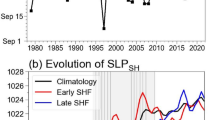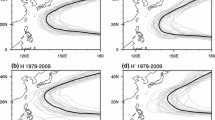Abstract
The Siberian High (SH), an important atmospheric system over Eurasia, exhibits notable seasonality—forming in autumn and peaking in the boreal winter. Many previous studies have revealed the characteristics of the SH in its peak phase; however, the SH formation process remains unclear. This study examined the climatological characteristics of SH formation with a cumulative sea-level-pressure series over the Siberian region based on observational data. First, the SH formation dates were objectively detected in both the climatology (October 1, 55th pentad) and individual years. Then, the thermodynamic processes around SH formation were investigated based on these formation dates. The results indicated that, in the lower troposphere, an anticyclonic circulation dominates over the Eurasian continent after SH formation. In the middle troposphere, an anomalous northeast–southwest-oriented ridge and trough appear over upstream of the SH and the coast of Northeast Asia, respectively. In the upper troposphere, the subtropical westerly jet, with its entrance located over the SH, intensifies and migrates southward, accompanying the amplification of its secondary circulation that features downward (upward) motion over Siberia (south of the Tibetan Plateau). The combined effects of the jet-associated circulation, negative vorticity advection and cold advection associated with the ridge and trough, and diabatic cooling contribute to high-level convergence and large-scale subsidence over the SH area, thereby resulting in SH formation. Further diagnosis reveals that dynamic processes play a more important role in SH formation than the thermal processes do.











Similar content being viewed by others
Data availability
The JRA-55 dataset (Kobayashi et al. 2015) is available at https://rda.ucar.edu/datasets/ds628.0/.
References
Bluestein HB (1993) Synoptic-dynamic meteorology in midlatitudes. Oxford University Press, New York
Bombardi RJ, Kinter JL, Frauenfeld OW (2019) A global gridded dataset of the characteristics of the rainy and dry seasons. Bull Am Meteorol Soc 100:1315–1328
Chang C-P, Lu M-M (2012) Intraseasonal predictability of Siberian High and East Asian winter monsoon and its interdecadal variability. J Clim 25:1773–1778
Chen W, Graf HF, Huang RH (2000) The interannual variability of East Asian winter monsoon and its relation to the summer monsoon. Adv Atmos Sci 17:48–60
Chen W, Feng J, Wu RG (2013) Roles of ENSO and PDO in the link of the East Asian winter monsoon to the following summer monsoon. J Clim 26:622–635
Chen S, Wei K, Chen W, Song L (2014) Regional changes in the annual mean Hadley circulation in recent decades. J Geophys Res Atmos 119:7815–7832
Chen L, Chen W, Hu P et al (2022) Climatological characteristics of the East Asian summer monsoon retreat based on observational analysis. Clim Dyn 60:3023–3037. https://doi.org/10.1007/s00382-022-06489-6
Cheng F, Li Q, Wang J et al (2022) Interdecadal variability of spring Eurasian snowmelt and its impact on eastern China summer precipitation. Front Earth Sci 10:927876
Cheung HHN, Zhou W (2016) Simple metrics for representing East Asian winter monsoon variability: urals blocking and western Pacific teleconnection patterns. Adv Atmos Sci 33:695–705
Cheung HN, Zhou W, Mok HY, Wu MC (2012) Relationship between Ural-Siberian Blocking and the East Asian Winter Monsoon in Relation to the Arctic Oscillation and the El Nino–Southern Oscillation. J Clim 25:4242–4257
Cohen J, Saito K, Entekhabi D (2001) The role of the Siberian High in northern hemisphere climate variability. Geophys Res Lett 28:299–302
Cook BI, Buckley BM (2009) Objective determination of monsoon season onset, withdrawal, and length. J Geophys Res Atmos 114(D23):D23109
Dai G, Mu M (2020) Arctic influence on the Eastern Asian cold surge forecast: a case study of January 2016. J Geophys Res Atmos. https://doi.org/10.1029/2020JD033298
Ding Y (1990) Build-up, air mass transformation and propagation of Siberian high and its relations to cold surge in East Asia. Meteorl Atmos Phys 44:281–292
Ding Y, Krishnamurti TN (1987) Heat budget of the Siberian High and the winter monsoon. Mon Weather Rev 115:2428–2449
Dong Z, Wang L, Yang R et al (2022) Impact of quasi-biweekly oscillation on Southeast Asian cold surge rainfall monitored by TRMM satellite observation. Remote Sens 14:5200
Dong Z, Wang L, Gui S et al (2023) Diminished impact of the East Asian winter monsoon on the maritime continent rainfall after the late-1990s tied to weakened Siberian High-Aleutian low covariation. Clim Dyn. https://doi.org/10.1029/2022JD037336
Fu J, Liu M, Wang R et al (2022) Possible impact of boreal winter Siberian High on ENSO development in the following year. Front Earth Sci. https://doi.org/10.3389/feart.2022.885846
Gao W, Duan K, Li S (2021) A spatial–temporal analysis of cold surge days in northern China during 1960–2016. Nat Hazards 108:147–162
Gong D-Y, Ho C-H (2002) The Siberian High and climate change over middle to high latitude Asia. Theor Appl Climatol 72:1–9
Gong D-Y, Wang S-W, Zhu J-H (2001) East Asian winter monsoon and Arctic Oscillation. Geophys Res Lett 28:2073–2076
Hasanean HM, Almazroui M, Jones PD, Alamoudi AA (2013) Siberian High variability and its teleconnections with tropical circulations and surface air temperature over Saudi Arabia. Clim Dyn 41:2003–2018
He Z (2012) The synoptic causation analysis of a sandstorm over Henan province at the end of March 2006. Meteorol Mon 38:932–942 (in Chinese)
Holton JR, Hakim GJ (2013) An introduction to dynamic meteorology. Academic Press, Cambridge
Hu P, Chen W, Huang R et al (2019) Climatological characteristics of the synoptic changes accompanying South China Sea summer monsoon withdrawal. Int J Climatol 39:596–612
Hu P, Chen W, Wang L et al (2022) Revisiting the ENSO–monsoonal rainfall relationship: new insights based on an objective determination of the Asian summer monsoon duration. Environ Res Lett 17:104050
Huang R, Chen S, Chen W, Hu P (2018) Interannual variability of regional Hadley circulation intensity over Western Pacific during boreal winter and its climatic impact over Asia–Australia region. J Geophys Res Atmos 123:344–366
Iqbal MJ, Riaz SMF, Ghauri BMK (2013) Impact of Siberian High on rainfall variability over Northern part of Indo-Pak region. Arab J Geosci 6:3087–3092
Jeong J-H, Ou T, Linderholm HW et al (2011) Recent recovery of the Siberian High intensity. J Geophys Res Atmos 116:D23102
Jia XJ, Lin H, Yao X (2014) The influence of tropical pacific SST anomaly on surface air temperature in China. J Climate 27:1425–1444
Jia XJ, Wang S, Lin H, Bao Q (2015) A connection between the tropical Pacific Ocean and the winter climate in the Asian-Pacific region. J Geophys Res-Atmos 120:430–448
Keller LM, Morgan MC, Houghton DD, Lazear RA (2006) Synoptic–dynamic climatology of large-scale cyclones in the North Pacific. Mon Weather Rev 134:3567–3587
Kim E-S, Ahn J-B (2023) Study on the classification and characteristics of cold surge in South Korea. Int J Climatol 43:720–735
Kobayashi S, Ota Y, Harada Y et al (2015) The JRA-55 reanalysis: general specifications and basic characteristics. J Meteorol Soc Japan Ser II 93:5–48
Liebmann B, Marengo J (2001) Interannual variability of the rainy season and rainfall in the Brazilian Amazon Basin. J Clim 14:4308–4318
Liu B, Zhu C (2020) Diverse impacts of the Siberian High on surface air temperature in Northeast China during boreal winter. Int J Climatol 40:594–603
Lü Z, He S, Li F, Wang H (2019) Impacts of the autumn Arctic Sea ice on the intraseasonal reversal of the winter Siberian High. Adv Atmos Sci 36:173–188
Luo X, Wang B (2019) How autumn Eurasian snow anomalies affect East Asian winter monsoon: a numerical study. Clim Dyn 52:69–82
Ma T, Chen W, Graf H-F et al (2020) Different impacts of the East Asian winter monsoon on the surface air temperature in North America during ENSO and neutral ENSO years. J Clim 33:10671–10690
Ma T, Chen W, Chen S et al (2022) Different ENSO teleconnections over East Asia in early and late winter: role of precipitation anomalies in the tropical Indian Ocean and far Western Pacific. J Clim 35:4319–4335
Noska R, Misra V (2016) Characterizing the onset and demise of the Indian summer monsoon. Geophys Res Lett 43:4547–4554
Panagiotopoulos F, Shahgedanova M, Hannachi A, Stephenson DB (2005) Observed trends and teleconnections of the Siberian High: a recently declining center of action. J Clim 18:1411–1422
Pang B, Lu R (2019) Two distinct types of extratropical circulation anomalies associated with cold surges over the South China Sea. J Clim 32:5069–5084
Park HJ, Ahn JB (2016) Combined effect of the Arctic Oscillation and the Western Pacific pattern on East Asia winter temperature. Clim Dyn 46:3205–3221
Park S-B, Cho J-A, Park SS et al (2021) A possible linkage between dust frequency and the Siberian High in march over Northeast Asia. Atmosphere 12:176
Riaz SMF, Iqbal MJ (2017) Singular value decomposition analysis for examining the impact of Siberian High on winter precipitation variability over South Asia. Theor Appl Climatol 130:1189–1194
Shi N, Wang X, Tian P (2019) Interdecadal variations in persistent anomalous cold events over Asian mid-latitudes. Clim Dyn 52:3729–3739
Takaya K, Nakamura H (2005a) Geographical dependence of upper-level blocking formation associated with intraseasonal amplification of the Siberian High. J Atmos Sci 62:4441–4449
Takaya K, Nakamura H (2005b) Mechanisms of intraseasonal amplification of the cold Siberian High. J Atmos Sci 62:4423–4440
Takaya K, Nakamura H (2013) Interannual variability of the East Asian winter monsoon and related modulations of the planetary waves. J Clim 26:9445–9461
Tubi A, Dayan U (2013) The Siberian High: teleconnections, extremes and association with the Icelandic Low. Int J Climatol 33:1357–1366
Wang B (2006) The Asian monsoon. Springer-Verlag, Berlin Heidelberg New York
Wu MC, Chan JCL (1997) Upper-level features associated with winter monsoon surges over South China. Mon Weather Rev 125:317–340
Wu B, Ding S (2022) Cold-Eurasia contributes to arctic warm anomalies. Clim Dyn. https://doi.org/10.1007/s00382-022-06445-4
Wu B, Wang J (2002) Winter Arctic Oscillation, Siberian High and East Asian winter monsoon. Geophys Res Lett 29:1–4
Wu B, Su J, D’Arrigo R (2015) Patterns of Asian Winter climate variability and links to Arctic Sea ice. J Clim 28:6841–6858
Yanai M, Esbensen S, Chu J-H (1973) Determination of bulk properties of tropical cloud clusters from large-scale heat and moisture budgets. J Atmos Sci 30:611–627
Zhang R, Sumi A, Kimoto M (1996) Impact of El Niño on the East Asian Monsoon. J Meteorol Soc Japan Ser II 74:49–62
Zhang R, Zhang R, Zuo Z (2017) Impact of Eurasian spring snow decrement on East Asian summer precipitation. J Clim 30:3421–3437
Zhou W, Chan JCL, Chen W, Ling J, Pinto JG, Shao Y (2009) Synoptic-scale controls of persistent low temperature and icy weather over southern China in January 2008. Mon Weather Rev 137:3978–3991
Acknowledgements
We thank two anonymous reviewers for valuable and constructive suggestions that help improve the manuscript a lot. Lingying Chen would like to thank Rodrigo J. Bombardi for helpful discussion about the utilize of accumulation approach.
Funding
National Natural Science Foundation of China (41721004).
Author information
Authors and Affiliations
Contributions
Conceptualization: WC and LC; methodology: LC and PH; formal analysis and investigation: WC, LC, PH, XA, and TM; writing—original draft preparation: LC; writing—review and editing: WC, PH, SC, XA, and ZW; supervision: WC. All authors have read and agreed to the manuscript.
Corresponding author
Ethics declarations
Conflict of interest
The authors declare that they have no conflict of interest.
Consent for publication
Written information consent for publication was obtained from all participants.
Ethics approval and consent to participate
Not applicable.
Additional information
Publisher's Note
Springer Nature remains neutral with regard to jurisdictional claims in published maps and institutional affiliations.
Rights and permissions
Springer Nature or its licensor (e.g. a society or other partner) holds exclusive rights to this article under a publishing agreement with the author(s) or other rightsholder(s); author self-archiving of the accepted manuscript version of this article is solely governed by the terms of such publishing agreement and applicable law.
About this article
Cite this article
Chen, L., Chen, W., Hu, P. et al. Processes and mechanisms of the initial formation of the Siberian High during the autumn-to-winter transition. Clim Dyn 62, 315–329 (2024). https://doi.org/10.1007/s00382-023-06911-7
Received:
Accepted:
Published:
Issue Date:
DOI: https://doi.org/10.1007/s00382-023-06911-7




